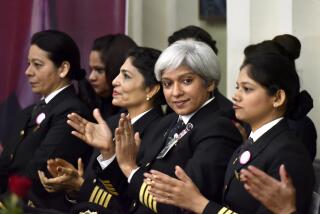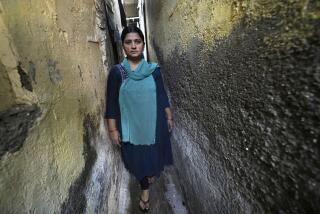Women Hope to Get Ahead in the Clouds Over India
- Share via
NEW DELHI — Like most of her classmates in flight attendant school, Sandhya Chatribin has never been on an airplane. At least not one that can fly.
The 19-year-old came here from the western coastal state of Goa the way most Indians travel long distances, in a rattling train that shimmied and squeaked its way hundreds of miles across the subcontinent.
It was a two-night trip in general class, where passengers sat on wooden slats or stretched out on homemade hammocks or, when floor space ran out, slouched in reeking toilets.
By looking skyward for work, Chatribin and her classmates have embarked on a journey from the old India to the new.
Millions of young Indians like her have a confidence born of a quiet revolution that is sweeping the country as its economy takes on the challenges of global competition, and easier travel opens the way to once unimagined opportunities.
“Look in the eyes of younger people and you see a new India,” said Kapil Kaul, regional head of the Center for Asia Pacific Aviation, a Sydney, Australia-based air transport consulting and research agency.
“They don’t think of India the way their parents did. They feel that India can be compared to any other country. They’re seeing a new, emerging India, a powerful India which wasn’t seen before.”
But some change comes slowly. Many Indian women Chatribin’s age are still under pressure to marry a man chosen by their parents, to quickly bear children and stay at home to care for family and in-laws.
Chatribin is the youngest in a middle-class family of 10. Her parents took a rather radical view of her future: They left it up to her.
“They realize this job is something which will keep me away from them,” she said. “But then, it was my choice, and my happiness lies in it.
“Society is changing quickly,” Chatribin said. “My mom is not very educated, but the younger generation is different, and she is changing with it.”
Many in Chatribin’s class of about 130 trainees come from farms in rural India, where 70% of the country’s 1 billion people still live. A flight attendant’s salary is just too attractive to let old social hang-ups get in the way, said Bhavna Tinari, Chatribin’s instructor at the Frankfinn Institute of Air Hostess Training.
“Everybody wants economic stability,” said Tinari, who was a flight attendant for six years in the 1980s. “They want to raise their standard of living.”
In Tinari’s day, the starting salary for a flight attendant, including perks, was a little more than $300 a month. Any of her students who find jobs will earn up to $560 a month, or more than double that if they get hired by airlines in the Middle East.
That may not seem a lot by Western standards, but it’s better than other jobs open to young women with a basic education, such as at the call centers that U.S. firms use to handle customer service and telemarketing. Call center jobs normally pay $159 to $204 a month, according to a study released last year.
Kaul has seen 5,000 people line up to interview for just one advertised opening for a flight attendant position.
A quarter of a century ago, when many of the old social rules were still firmly entrenched, thinking of an airline job would have been a flight of fantasy for most young Indians living outside the more cosmopolitan cities.
In 1982, when Tinari was looking into becoming an Air India flight attendant, custom dictated that her entire extended family would decide what, if any, career she could pursue.
Her uncle, a state deputy director of education, was scandalized that she was about to go flying around unchaperoned, serving food and drinks to strangers.
“He thought that this was a very ‘loose’ sort of a profession,” she said. “My younger brother supported me through thick and thin, and he said something to my parents which also clicked with my uncle.
“He said, ‘We have never been able to get in an airplane. If she’s able to sit in one, why don’t you just let her go?’ ”
Today, India’s flight attendants have earned wide respect in their country as members of a well-paid elite “roaming around the world getting to know different cultures,” Tinari said.
The old India is on the rails, where an accident-prone passenger train system dating back to 1854 is struggling to break the chains of a corrupt bureaucratic system that has dominated India for generations.
The state-owned Indian Railways is the world’s largest. It carries 13 million passengers each day on about 7,000 trains that crisscross the subcontinent. Outdated technology and infrastructure contribute to the estimated 300 serious railway accidents reported each year. But for the last century and a half, most Indians with a long way to go have been forced to take their chances on a train.
Cars and planes catered mostly to the middle and upper classes. The poor majority had more basic choices: walk, hitch up a cart or buy a train ticket.
Until 1991, when India opened its economy to more domestic and foreign competition, the only way to fly was on two state-owned carriers, Air India and Indian Airlines.
Today there are at least nine Indian airlines vying for passengers. Competition has driven prices so low that Indian Railways is offering incentives to keep train passengers from switching to planes.
An air ticket from Delhi to the high-tech hub of Bangalore that cost about $500 last year has dropped by 70% to just $147 today, Kaul said. Similar discounts are offered on other routes as well-established carriers compete with newer, no-frills airlines. Some offer advance seats for as low as $11.
India’s airlines are expanding fast and have ordered more than 420 aircraft, worth up to $30 billion, from U.S. aircraft maker Boeing and Europe’s Airbus.
Yet they can’t find enough Indian pilots to fly the new planes. They are currently short about 250 pilots, and the deficit will soar to about 5,000 over the next decade, Kaul said.
For the first time, India has been forced to open its doors to foreign pilots, another seismic shift in a country where Mohandas K. Gandhi’s principle of economic self-reliance was once a national mantra.
At the Frankfinn Institute, students pay more than $2,000 for a one-year part-time course in the hope they will have an edge when interviewing with airlines, which have their own training programs for successful applicants.
Frankfinn has 40 training centers across India where students spend weeks learning personal grooming, cabin service and arcane information, such as the fact that aircraft tires are filled with nitrogen because it is noncombustible. More than 7,000 trainees have graduated in the last two years, but Tinari said she didn’t know how many were hired by airlines.
She teaches students how to serve passengers, maintain safety and handle emergencies in an old Airbus 300B airliner that sits on a small lot behind New Delhi’s decrepit airport.
The craft was part of Indian Airlines’ fleet, but it was damaged in a runway incident.
On a recent day, Chatribin and her classmates took turns learning how to slide down an emergency chute inflated by a noisy generator.
Chatribin, who is working on a bachelor of arts degree while training part time to be a flight attendant, is drawn to the airline industry by its seeming glamour, and the chance to travel and work at the same time.
Although they support her dream, the rest of her family still sees her as a bit of an oddball, Chatribin said. It’s a pioneer’s fate.
“My sisters are all married and having daughters like me,” she said, giggling. “I’m the only one still not married in my family, and studying. So I’m the luckiest one.”
More to Read
Sign up for The Wild
We’ll help you find the best places to hike, bike and run, as well as the perfect silent spots for meditation and yoga.
You may occasionally receive promotional content from the Los Angeles Times.






